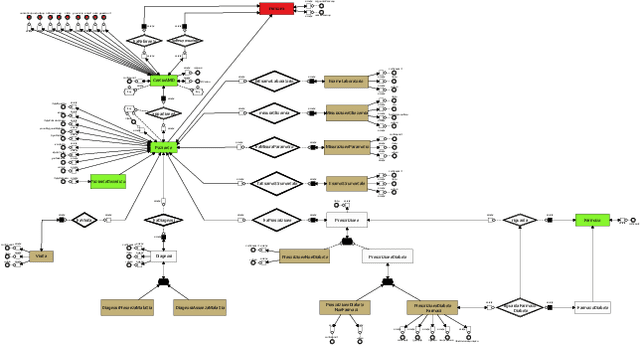Maurizio Lenzerini
AI-based Data Preparation and Data Analytics in Healthcare: The Case of Diabetes
Jun 13, 2022
Abstract:The Associazione Medici Diabetologi (AMD) collects and manages one of the largest worldwide-available collections of diabetic patient records, also known as the AMD database. This paper presents the initial results of an ongoing project whose focus is the application of Artificial Intelligence and Machine Learning techniques for conceptualizing, cleaning, and analyzing such an important and valuable dataset, with the goal of providing predictive insights to better support diabetologists in their diagnostic and therapeutic choices.
QDEF and Its Approximations in OBDM
Aug 23, 2021Abstract:Given an input dataset (i.e., a set of tuples), query definability in Ontology-based Data Management (OBDM) amounts to find a query over the ontology whose certain answers coincide with the tuples in the given dataset. We refer to such a query as a characterization of the dataset with respect to the OBDM system. Our first contribution is to propose approximations of perfect characterizations in terms of recall (complete characterizations) and precision (sound characterizations). A second contribution is to present a thorough complexity analysis of three computational problems, namely verification (check whether a given query is a perfect, or an approximated characterization of a given dataset), existence (check whether a perfect, or a best approximated characterization of a given dataset exists), and computation (compute a perfect, or best approximated characterization of a given dataset).
On the evolution of the instance level of DL-lite knowledge bases
Apr 20, 2011Abstract:Recent papers address the issue of updating the instance level of knowledge bases expressed in Description Logic following a model-based approach. One of the outcomes of these papers is that the result of updating a knowledge base K is generally not expressible in the Description Logic used to express K. In this paper we introduce a formula-based approach to this problem, by revisiting some research work on formula-based updates developed in the '80s, in particular the WIDTIO (When In Doubt, Throw It Out) approach. We show that our operator enjoys desirable properties, including that both insertions and deletions according to such operator can be expressed in the DL used for the original KB. Also, we present polynomial time algorithms for the evolution of the instance level knowledge bases expressed in the most expressive Description Logics of the DL-lite family.
Conjunctive Query Containment and Answering under Description Logics Constraints
Jul 28, 2005



Abstract:Query containment and query answering are two important computational tasks in databases. While query answering amounts to compute the result of a query over a database, query containment is the problem of checking whether for every database, the result of one query is a subset of the result of another query. In this paper, we deal with unions of conjunctive queries, and we address query containment and query answering under Description Logic constraints. Every such constraint is essentially an inclusion dependencies between concepts and relations, and their expressive power is due to the possibility of using complex expressions, e.g., intersection and difference of relations, special forms of quantification, regular expressions over binary relations, in the specification of the dependencies. These types of constraints capture a great variety of data models, including the relational, the entity-relationship, and the object-oriented model, all extended with various forms of constraints, and also the basic features of the ontology languages used in the context of the Semantic Web. We present the following results on both query containment and query answering. We provide a method for query containment under Description Logic constraints, thus showing that the problem is decidable, and analyze its computational complexity. We prove that query containment is undecidable in the case where we allow inequalities in the right-hand side query, even for very simple constraints and queries. We show that query answering under Description Logic constraints can be reduced to query containment, and illustrate how such a reduction provides upper bound results with respect to both combined and data complexity.
 Add to Chrome
Add to Chrome Add to Firefox
Add to Firefox Add to Edge
Add to Edge